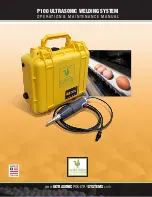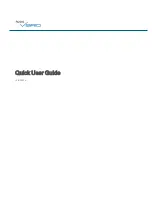
18
GB
•
Extension cables to be used outdoors only. For out-
door work, use extension cables adequately marked
and approved for that purpose.
•
Unplug the appliance
- before every cleaning
- after each use
•
Persons unable to operate the appliance due to their
physical, sensory or mental abilities or their inexperi-
ence or lack of knowledge must not operate it.
•
If the appliance, feeder cable or steel cable show
any sign of visible damage the appliance must not
be put into operation.
•
If the feeder cable of the appliance is damaged it
needs to be replaced by the producer or an electri-
cian.
•
Repairs of the appliance can only be executed by an
electrician. There might be significant risks as a re
-
sult of unauthorised repairs.
•
The same regulations apply for accessories.
Additional safety instructions for welding set
•
Always wear gloves of insulation fabric.
•
Wear suitable clothing, avoid any clothing of syn-
thetic material.
•
Wear heavy-duty insulating shoes.
•
Make sure that working area is properly ventilated
to prevent accumulation of harmful fumes and toxic
smoke
•
Never work in wet places without efficient safety
measures against electrical discharges
•
After the work, the electrode has to be taken from
the electrode tongs to prevent undesired arc forma-
tion.
•
The welding machine should not be used or stored in rain.
•
If the unit is in operation, the electrode tongs should
not be put on the unit or other electric appliances as
the safety device may get damaged or disconnected
when grounded.
•
Do not touch the electrode or another metal object
in contact with the electrode while welding is in pro-
gress
•
Check that all cables are coated (mainly the con-
tacts with the power cable). The cables with insuffi
-
cient insulation should be immediately replaced with
the same size cables meeting the regulations. Dis-
connect the unit from the source where not used.
•
The unit may influence supply of other units accord
-
ing to characteristics of the mains. Seek advice from
an authority responsible for the power supply when-
ever in doubt.
•
Use only the welding cables supplied (10 mm
2
rub-
ber-sheathed welding cables).
•
To ensure that sufficient air can be drawn in through
the ventilation slits, the appliance should not be con-
stricted or placed next to a wall while it is operating.
Make sure that the appliance is correctly connected
to the mains supply. Do not subject the mains lead
to any tensile stress. Unplug the appliance before
you change its position.
•
Check the condition of the welding cables, the elec-
trode tongs and the earth terminals; wear on the
insulation and the live parts may result in danger-
ous conditions and reduce the quality of the welding
work.
•
Arc welding generates sparks, molten metal parti-
cles and smoke, so the following is required: Re-
move all inflammable substances and/or materials
from the working area.
•
Do not weld on tanks, vessels or pipes that have
contained inflammable liquids or gases. Avoid all
direct contact with the welding circuit; the idling volt-
age between the electrode tongs and the earth ter-
minal may be dangerous.
•
Do not store or use the appliance in wet or damp
conditions or in the rain.
•
Protect your eyes with specially designed goggles
(DIN level 9-10). Wear gloves and dry safety cloth-
ing that are not contaminated by any oil or grease
to ensure that your skin is not exposed to ultravio-
let radiation from the arc. Do not use this welder to
defrost pipes
Remember.
•
The radiation from the arc can damage your eyes
and cause burns on skin.
•
Arc welding generates sparks and droplets of molten
metal; the welded workpiece may start to glow and
will remain very hot for a relatively long period of
time.
•
Arc welding releases vapors that may be harmful.
Every electric shock is potentially fatal.
•
Do not approach the arc within a radius of 15 m un-
protected.
•
Protect yourself (and others around you) against the
possible hazardous effects of the arc.
•
Warning: Depending on the mains connection con-
ditions at the connection point of the welding set,
other consumers connected to the mains may suffer
faults.
•
Important!
If the supply mains and circuits are overloaded,
other consumers may suffer interference during the
welding work. If you have any doubts, contact your
electricity supply company.
Sources of danger during arc welding
Arc welding results in a number of sources of danger.
It is therefore particularly important for the welder to
comply with the following rules so as not to place him-
self or others in danger and to avoid endangering peo-
ple and equipment.
•
Have all work on the mains voltage system, for ex-
ample on cables, plugs, sockets, etc.,performed only
by trained electricians. This particularly applies to
configuring intermediate cables.
•
If an accident occurs, disconnect the welding power
source from the mains immediately.
•
If electric touch voltages occur, switch off the weld-
ing set immediately and have it checked by an ex-
pert.
Summary of Contents for WSE850
Page 3: ...3 1 3 4 6 5 1 2 9 8 7 2 6 5 4 3 1 2 ...
Page 4: ...5 4 6 5 10 ...















































